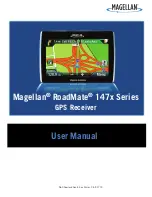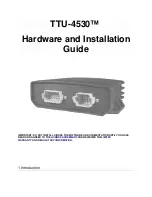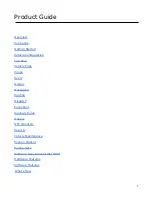
1 Using the swivel base as a template, mark the pilot holes through
the outer three screw holes.
2 Using a 3 mm (
1
/
8
in.) drill bit, drill the three pilot holes.
3 Press the hex end of the lock nut into the center recess on the
underside of the swivel base.
The dome end of the lock nut must face the mounting surface.
4 Align the outer three screw holes in the swivel base with the pilot holes.
5 Use the included wood screws to secure the swivel base to the
mounting surface.
6 Place the bail-mount bracket on the swivel base.
7 Insert the swivel-mount bolt through the center hole in the bail mount.
8 Tighten the swivel-mount bolt with a #2 Phillips screwdriver to securely
assemble the bail-mount bracket, swivel base, and lock nut.
Do not over-tighten.
9 Loosely install the bail-mount knobs.
10 Place the device in the bail-mount bracket.
11 Tighten the bail-mount knobs.
Flush Mounting the Device
NOTICE
Be careful when cutting the hole to flush mount the device. There is only a
small amount of clearance between the case and the mounting holes, and
cutting the hole too large could compromise the stability of the device after it
is mounted.
NOTICE
Using a metal pry tool such as a screwdriver can damage the trim caps and
the device. Use a plastic pry tool when possible.
You can mount the device in your dashboard using the flush-mount template
and appropriate hardware.
1 Trim the template and make sure it fits in the location where you want to
mount the device.
2 Secure the template to the mounting location.
3 Using a 9.5 mm (
3
/
8
in.) drill bit, drill one or more of the holes inside the
corners of the solid line on the template to prepare the mounting surface
for cutting.
4 Using a jigsaw or rotary cutting tool, cut the mounting surface along the
inside of the solid line indicated on the template.
5 Place the device into the cutout to test the fit.
6 If necessary, use a file and sandpaper to refine the size of the hole.
7 If your device has trim caps, use a plastic pry tool or a flat piece of plastic
to carefully pry up the corners of the trim caps , slide the pry tool to the
center , and remove the trim caps.
8 Ensure the mounting holes on the device line up with the pilot holes on
the template.
9 If the mounting holes on the device do not line up with the pilot holes on
the template, mark the new pilot-hole locations on your template.
10 Using a 3 mm (
1
/
8
in.) drill bit, drill the pilot holes.
11 Remove the template from the mounting surface.
12 If you will not have access to the back of the device after you mount it,
connect the power and transducer cables.
You can press to power the device on and off to test the connections.
13 Install the rubber gasket pieces on the back of the device.
The pieces of the rubber gasket have adhesive on the back. Make sure
you remove the protective liner before installing them on the device.
14 Place the device into the cutout.
15 Secure the device to the mounting surface using the included screws .
16 Install the trim caps by snapping them in place around the edges of the
device.
Connection Considerations
Connector View
POWER
Power cable port
XDCR
4-pin transducer cable port
Power Cable
WARNING
When connecting the power cable, do not remove the in-line fuse holder. To
prevent the possibility of injury or product damage caused by fire or
overheating, the appropriate fuse must be in place as indicated in the product
specifications. In addition, connecting the power cable without the
appropriate fuse in place voids the product warranty.
2





















